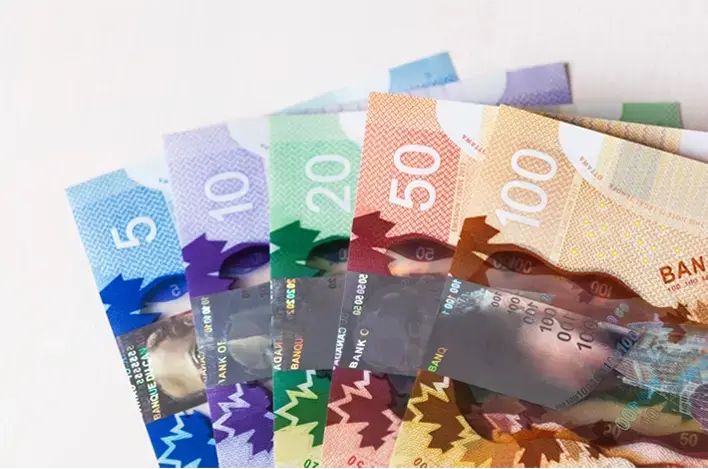
Currency Spotlight - Canadian Dollar
The main point of comparison for the CAD has always been the USD, thanks to Canada’s proximity and important economic relationship with the United...
For most of us, the Canadian dollar is just another part of life. Whether a loonie, toonie, new bill, or old – the dollar has been the currency used in Canada for over 150 years.
Fast Facts: Dollar
- Canadian dollar Symbol:$
- Canadian Currency Code: CAD
- Coins: 5¢, 10¢, 25¢, 50¢ (rare), $1, $2
- Banknotes: $5, $10, $20, $50, $100
- Canadian GDP (nominal):US$1.788 trillion (11th)
- Central Bank: Bank of Canada
History: Currency used in Canada
The history of modern currency in Canada begins with the Canadian pound. Adopted in 1841, it was equal to four US dollars at the time. The ensuing decades however brought much debate about whether to persist with the sterling system or switch to the increasingly popular decimal system (one unit subdivided into a hundred smaller ones). After much debate and compromise, the decision was finally made in 1857 to adopt the decimal system, partly due to increased trade with the US. As a result, the new Canadian dollar was introduced in 1858.
Throughout the second half of the 19th century, British Columbia, New Brunswick, PEI, and Nova Scotia decimalized their currency – though they all joined the dominion of Canada before long. Newfoundland also decimalized, though their basis for comparison was initially the Spanish dollar (which resulted in a slightly higher value currency). In 1895, the Newfoundland dollar was pegged to the Canadian dollar, which lasted into Newfoundland joined Canada in 1949.
The 20th century saw the gold standard abandoned in 1933 during the Depression. From the outbreak of World War II and continuing for the next couple of decades, the Canadian dollar was alternatively pegged to the US dollar at different amounts or allowed to float. In 1970, the peg was removed for good and the dollar now floats freely against other major currencies.
Notes and Coins
There have been numerous series of Canadian banknotes released over the years. Some feature Canadian scenes, others the reigning monarch, while some put the focus on previous prime ministers. The current series, known as the Frontier series, was released in 2011. The notes are differentiated by colour and feature four prime ministers (Sir Wilfred Laurier, Sir John A. Macdonald, William Lyon Mackenzie King, and Sir Robert Borden) as well as Queen Elizabeth II on the $20 bill. The notes are also differentiated by designs on the reverse, including the Canadarm2 on the ISS, the Vimy Memorial, and the CCGS Amundsen. The most well-known feature of the current series of notes is that they’re all made from polymer.
Two of the most well-known Canadian coins are the $1 and $2. The $1 is known as the loonie (due to the bird which appears on the coin) and the $2 is known colloquially as the toonie (get it?). One of the more significant events in Canadian coinage recently was the cessation of penny circulation in 2013. Now, all cash transactions are rounded to the nearest 5¢.
Value
The main point of comparison for the CAD has always been the USD, thanks to Canada’s proximity and important economic relationship with the United States. Since 1998, the Bank of Canada has made it a point not to intervene to affect the currency’s value. While occasional minor adjustments might be made, the CAD floats freely for the most part. In modern times, the CAD is usually found close to par or just below the value of the USD. There have been times when the CAD is valued higher than the USD, reaching a recent high 1 USD to 0.907 CAD on November 7, 2007. In the past 10 years, the lowest value the CAD has fallen to relative the USD is 1.2862 CAD to 1 USD on March 6, 2009. While the CAD was valued higher than the USD for brief periods between 2010 and 2012, the strong USD has returned the gulf between the two currencies to close to a modern high.
Canadian Economy
Canada is one of the wealthiest countries in the world and is a member of many international and regional organizations such as the G7. Like many highly developed countries, Canada has a diversified economy with a large service sector. Accounting for about 78% of the GDP, the service sector includes retail, business, education, health, high-tech (especially entertainment software), and tourism. Logging is an important industry, as is petroleum. Canada is a net exporter of energy – rare among developed countries.
Final Thoughts
The Canadian dollar is and will continue to be one of the world’s most important and most traded currencies. The economy is strong, with a diverse base.
.png?width=320&height=62&name=logomapleleaf%20(1920%20x%20372%20px).png)
